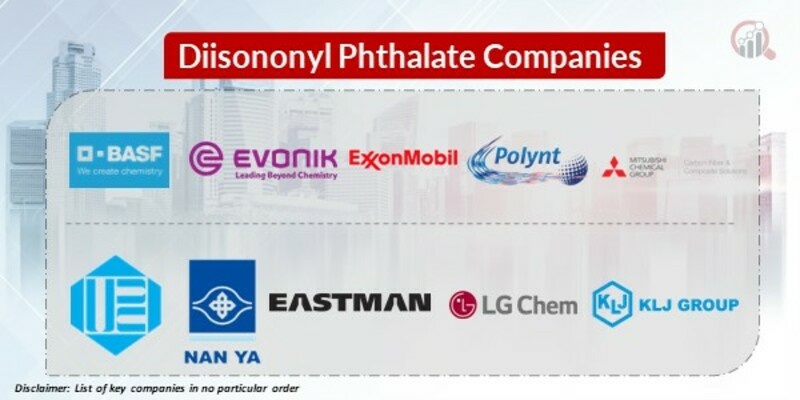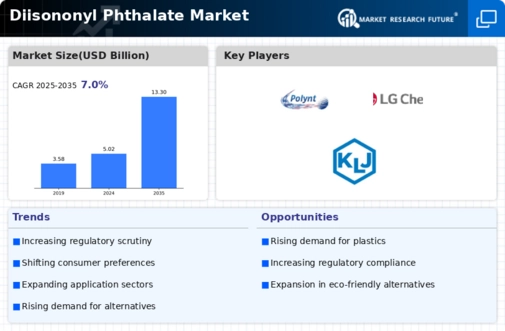Top Industry Leaders in the Diisononyl Phthalate Market

Diisononyl phthalate (DINP), a phthalate-based plasticizer widely used in PVC products, finds itself in a dynamic and competitive market. While facing headwinds from regulatory concerns and potential substitutes. This growth is driven by factors like rising demand for flexible PVC in construction, wires & cables, and automotive applications. However, navigating this landscape requires strategic maneuvering by players, with key factors like production capacity, regional focus, product diversification, and sustainability initiatives influencing market share.
List of Strategies Adopted:
- Mergers & Acquisitions: Leading players like BASF, ExxonMobil, and LG Chem are consolidating their positions through strategic acquisitions of regional players or smaller competitors. This helps them expand their geographic reach and production capacity.
- Product Diversification: Companies are developing and offering alternative plasticizers with low-phthalate or non-phthalate formulations to cater to regulatory pressures and meet growing consumer demand for safer products. Examples include DEHP-free plasticizers like trimellitates and non-phthalate plasticizers like epoxidized soybean oil (ESBO).
- Technological Advancements: Investments in R&D are aimed at improving DINP efficiency, such as developing plasticizers with higher heat resistance, lower volatility, and improved compatibility with specific PVC applications.
- Focus on Sustainability: Sustainability certifications and eco-friendly production processes are becoming increasingly important for market differentiation. Companies are adopting bio-based plasticizers or recycled PVC as feedstock to reduce their environmental impact.
- Regional Expansion: Emerging markets in Asia Pacific, particularly China and India, are witnessing robust growth in the construction and automotive sectors, driving demand for DINP. Players are strategically expanding their production footprints in these regions to capitalize on this potential.
Factors for Market Share:
- Production Capacity and Geographical Reach: Companies with larger production capacities and a diverse geographical presence have an edge in meeting fluctuating regional demands and securing larger contracts.
- Pricing Strategy: Offering competitive pricing while maintaining product quality is crucial for attracting customers and gaining market share.
- Brand Reputation and Customer Relationships: Building trust and establishing strong relationships with end-users in key industries contributes to brand loyalty and market share expansion.
- Regulatory Compliance: Stringent regulations in some regions regarding phthalate use necessitate continuous compliance efforts. Companies demonstrating consistent adherence to regulations gain an advantage over non-compliant ones.
- Technological Innovation: Investing in R&D and developing innovative DINP formulations with improved performance and reduced environmental impact attracts customers and expands market share.
List of Key Players in the Diisononyl Phthalate Market
- BASF SE (Germany),
- Evonik Industries AG (Germany),
- Exxon Mobil Corporation (US),
- Polynt (Italy),
- Mitsubishi Chemical Corporation (Japan),
- UPC Technology Corporation (Taiwan),
- Nan Ya Plastics Corporation (Taiwan),
- Eastman Chemical Company (US),
- LG Chem (South Korea),
- KLJ Group (India),
- Aekyung Petrochemical Co., Ltd. (South Korea),
- Guandong Chunda Chemical Industry (China),
Recent Developments:
August 2023: The European Union (EU) updated its Restriction of Hazardous Substances (RoHS) directive, further restricting the use of certain phthalates, including DINP, in specific applications.
September 2023: Aekyung Petrochemical Co., Ltd. announces plans to expand its DINP production capacity to meet growing demand. This could affect market competition.
October 2023: A LinkedIn post highlighted a report analyzing the U.S.A. DINP market in 2024, including key players, market share, and growth potential.
November 2023: Leading DINP manufacturers announce advancements in developing more sustainable and eco-friendly phthalate alternatives. This could influence future market trends.
December 2023: IndianPetroChem.com reported fluctuations in DINP prices in India, impacted by global energy and raw material costs. This price volatility can affect market dynamics in the region.









